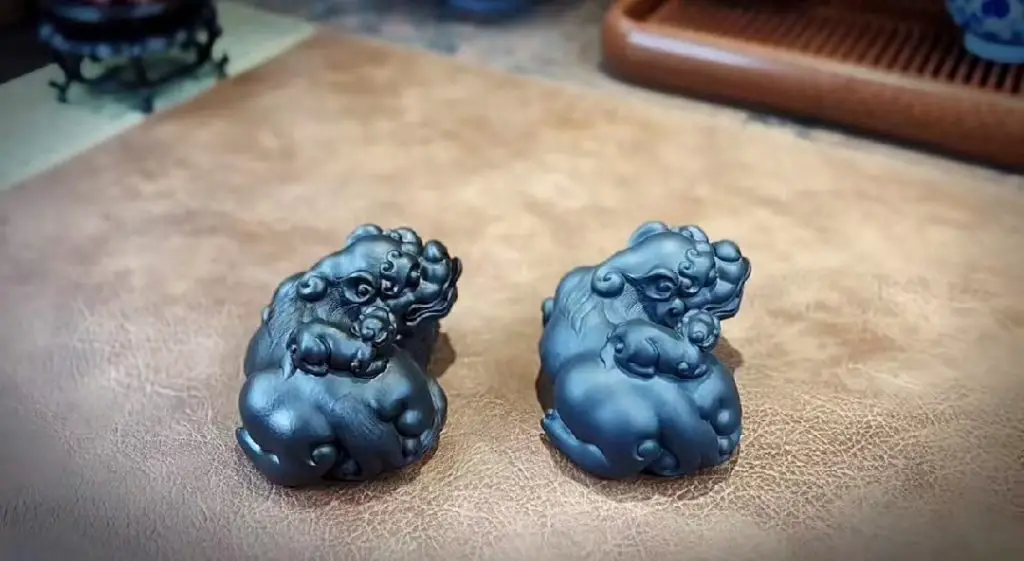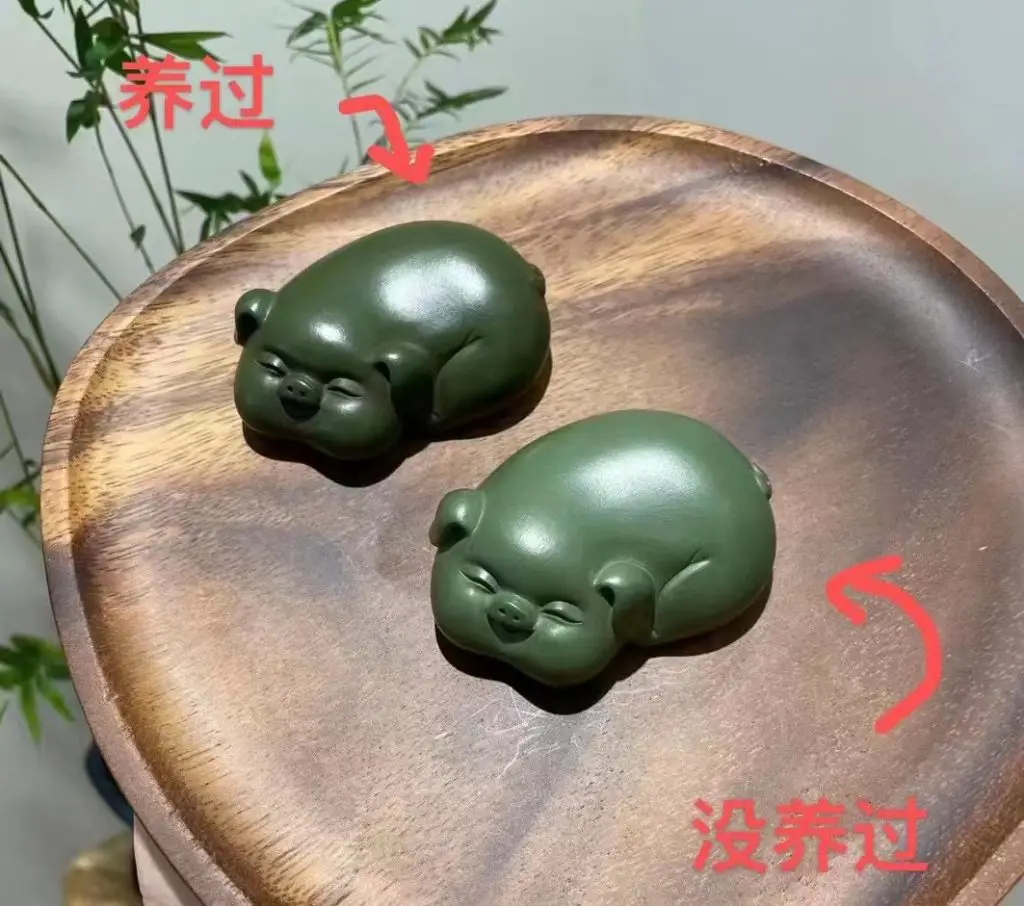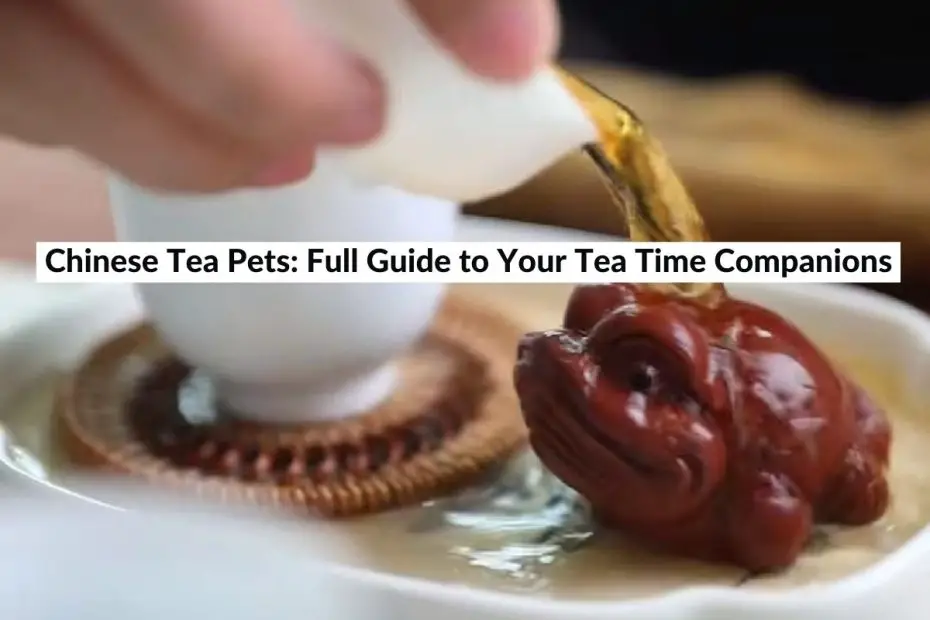Get ready for a thrilling journey through the fantastical realm of Chinese tea pets. We’ll explore their curious beginnings, the tales they weave, and the captivating art of making them. 🍵
Whether you’re a tea lover or simply a curious soul, let’s embark on a quest to uncover the captivating mysteries of these delightful companions, turning every tea break into a daring escapade!
What Are Chinese Tea Pets?
Chinese tea pets, also known as “tea pets” or “tea pets animals,” are small figurines or sculptures traditionally made from clay or ceramic materials.
They are used in conjunction with the practice of gongfu tea brewing (Check the best gongfu tea sets), a traditional Chinese method of preparing and serving tea.
Tea pets serve both decorative and functional purposes in Chinese tea culture.
Gongfu tea sets with Tea Pet is considered a very nice gif for business. Any other Chinese business gift ideas? Click to find out!😊💪
Tea Pet Origin
The tradition of clay tea pets has its roots tracing back to the Yuan dynasty in 13th century China, specifically in the town of Yixing. Renowned for its distinctive clay, known as zisha, and the exquisite teaware crafted from it, Yixing stands as the birthplace of this cultural practice.
(Check the best tea pots in the world made from Yixing.)
How To Make a Tea Pet?
Materials Needed:
- Clay: Choose a type of clay suitable for sculpting, such as air-dry clay or polymer clay.
- Sculpting Tools: Gather tools like a knife, shaping tools, a rolling pin, and other utensils for sculpting and detailing.
- Work Surface: Set up a clean, flat surface to work on, like a ceramic tile or a wooden board.
- Reference Images: Have images of the tea pet design you want to create for visual guidance.
- Paints and Brushes (optional): If desired, prepare paints and brushes for adding color to your tea pet after it dries.
Steps to Make a Clay Tea Pet:
- Design Concept:
- Decide on the type of tea pet you want to create (animal, mythical creature, etc.).
- Research and gather reference images for inspiration.
- Prepare Clay:
- Knead the clay to make it pliable and easy to work with.
- Roll the clay into a ball to begin shaping.
- Basic Shape:
- Create the basic outline of your tea pet by shaping the clay ball into the desired form.
- Keep the proportions and symmetry in mind.
- Refine the Shape:
- Use sculpting tools to add more details and define the features of your tea pet.
- Sculpt facial features, limbs, and other defining characteristics.
- Surface Texture:
- Add textures and patterns to the tea pet using sculpting tools or other objects.
- Ensure a smooth and even surface.
- Finishing Touches:
- Pay attention to small details that enhance the tea pet’s appearance.
- Smooth out any rough edges or imperfections.
- Drying:
- Allow the clay tea pet to air dry according to the clay’s instructions.
- This might take a few hours to several days, depending on the clay type.
- Painting (Optional):
- If desired, paint your tea pet after it’s completely dry.
- Use suitable paints and brushes to add color and character.
- Allow the paint to dry before proceeding.
- Test with Tea:
- Place your finished tea pet on your tea tray or table.
- During tea sessions, pour tea over the tea pet to create a unique patina over time.
How To Use a Tea Pet?
Selection and Placement:
Choose a tea pet that resonates with you, whether it’s based on the Chinese zodiac, a mythical creature, or any other design you like.
Place the tea pet on your tea tray or brewing area, where it can be easily seen and reached during your tea sessions.
How To Feed a Tea pet:
Prepare a pot of hot tea that you plan to drink during your tea session. The type of tea doesn’t matter; you can use any tea you enjoy.
Pour the hot tea over the entire surface of the tea pet. This “feeding” process helps the porous clay absorb the tea, which gradually changes the appearance and aroma of the tea pet over time.
How to Care for Your Own Chinese Tea Pet:
Whenever you brew tea, remember to pour a small amount of hot tea over the tea pet as an offering. This maintains the connection and helps the tea pet develop its unique characteristics.
Over time, the color of the clay will change, and a pleasant aroma from the absorbed teas will develop.
Observing Changes:
Watch for changes in the appearance of the tea pet. The clay may become darker or take on different hues as it absorbs more tea. You may notice a semi-glossy finish developing on the surface.
Symbolic Connection:
Some tea enthusiasts believe that the tea pet “develops a soul” over time through this attentive care and the absorbed tea. The semi-glossy finish is seen as a sign of this connection.
Embrace the symbolic meaning and connection you feel with your tea pet. It can serve as a reminder of your tea journey and the time you’ve invested in your tea practice.
Enjoyment and Sharing:
During your tea sessions, enjoy the presence of your tea pet as a companion. Share stories and experiences with fellow tea enthusiasts who appreciate the tradition.
Share the practice of using tea pets with others, introducing them to the concept and encouraging them to adopt their own tea pets.
What Are Tea Pets Made Of?
Tea pets are typically made from special porous clay, often referred to as “Yixing clay”, “purple clay” or “Zisha“. This type of clay is renowned for its unique properties and is traditionally used to craft teapots (BEST YIXING TEAPOTS HERE) and other tea-related accessories.
Yixing clay is known for its ability to absorb and retain the flavors and aromas of tea, which is why it is favored for making tea pets. The porous nature of the clay allows it to gradually absorb the tea that is poured over it during tea sessions, leading to changes in color and aroma over time.
Tea Pets Meaning
| Tea Pet Animal | Symbolic Meaning |
|---|---|
| Dragon Tea Pet | Symbolizes power, strength, and prosperity. Dragons are mythical creatures associated with good luck, protection, and the emperor’s authority. |
| Pee Pee Boy Tea Pet | Represents humor and fun. This playful tea pet “pees” when hot tea is poured over it, bringing laughter and lightheartedness to the tea-drinking experience. |
| Tea Pet Pig | Signifies wealth, abundance, and good fortune. Pigs are associated with prosperity and happiness in Chinese culture. |
| Tea Pet Tiger | Represents courage and strength. Tigers symbolize bravery and protection against negative forces, making it a potent guardian figure. |
| Nine-Tailed Fox Tea Pet | Symbolizes transformation and magic. The nine-tailed fox is a mythological creature often associated with shape-shifting and supernatural abilities. |
| Tea Pet Lion | Signifies power, majesty, and guardianship. Lions are considered protectors and are often placed to safeguard the tea area and its surroundings. |
| Tea Pet Turtle | Represents longevity and stability. Turtles are associated with a long life and symbolize endurance, strength, and a sense of grounding. |
| Lotus Tea Pet | Symbolizes purity and enlightenment. The lotus flower grows in muddy water yet remains untainted, representing spiritual growth and the pursuit of wisdom. |
| Cat Tea Pet | Represents grace and independence. Cats are seen as graceful and self-sufficient animals, embodying qualities of elegance and freedom. |
| Tea Pet Dog | Signifies loyalty and companionship. Dogs are known for their loyalty and friendship, making this tea pet a symbol of strong bonds and relationships. |
| Rabbit Tea Pet | Symbolizes fertility and creativity. Rabbits are associated with growth and new beginnings, reflecting the idea of constant renewal and positive change. |
| Ox Tea Pet | Represents hard work and diligence. The ox is a symbol of industriousness and reliability, embodying qualities of determination and steady progress. |
| Elephant Tea Pet | The elephant tea pet embodies wisdom, strength, and unity, symbolizing a quest for knowledge, resilience in the face of challenges, and the importance of close bonds in the art of tea. |
Ever heard about Yixing tea pets, purple clay tea pets, or the zisha tea pets? Well, they’re kind of the same, but they have their own special vibes.
Imagine this: There’s a place called Yixing, like a superstar city in China’s Jiangsu province. People there have been making awesome clay teapots and pottery for ages. These teapots teapets are like works of art, and they have superpowers, too. When we say “Yixing,” we’re talking about teapots made from the special clay in that cool city.
Now, let’s talk colors. There’s this clay that’s like a natural chameleon – it can be reddish-brown or even purplish-brown. So, everyone calls it “purple clay” or “zisha” in Chinese.
This clay is like a tea wizard – it loves tea so much that it soaks up all the yummy flavors and makes your tea taste even better each time. That’s why the clever teapot makers use this special clay to make teapots and tea pets. They know how to bring out the best in your tea!
Oldest Tea Pet
These charming companions have a history that stretches all the way back to the Yuan Dynasty (1206-1368 AD). During that time, creative pottery artists started turning teapot leftovers into delightful little figures.
They crafted these whimsical characters from spare clay, not just to amuse themselves but also to bring joy to their clients. It’s like these clay buddies have been spreading smiles for centuries!
Tea Pet Before After


| Aspect | Before Care | After Care |
|---|---|---|
| Aroma | Smoky and earthen notes from firing process | Develops a rich and enticing tea aroma |
| Texture | Rough surface, sandy sensation when touched | Smooth and polished, delicate tactile feel |
| Luster | Dull and coarse appearance | Develops a noticeable shine and sheen |
| Value | Ordinary decorative items | Transforms into valuable collectible items |
| Minimal collectible value | Enhanced texture and luster increase value | |
| Potential economic benefits for some tea pets |
Aroma
Tea pets, decorative items placed on tea trays, undergo a significant transformation during the process of brewing tea. When freshly made, they carry the lingering scent of firing, primarily characterized by smoky and earthen notes. Over time, with prolonged exposure to tea infusions, tea pets develop a distinct change in aroma. Initially simple in fragrance, they gradually emit a rich and enticing tea scent.
Texture
Before being cared for, tea pets serve primarily as decorative pieces, often with a relatively rough surface, giving a sandy sensation when touched. However, with meticulous care over an extended period, their surfaces appear visually smoother and more polished, offering a delicate and refined tactile experience.
Luster
The luster of tea pets undergoes a noticeable transformation from before to after being cared for. Prior to care, they lack apparent shine and appear rather dull and coarse. Through dedicated maintenance over time, their original lackluster appearance gradually gives way to a heightened sheen. For tea pets crafted from purple clay, a patina may even develop on the surface.
Value
A distinct difference between tea pets before and after care lies in their collectible value. Untreated tea pets hold minimal value, merely serving as ordinary decorations or crafts. With prolonged care, their texture and surface luster undergo substantial changes, elevating them from mere crafts to valuable collectibles. Some tea pets may even yield certain economic benefits.
FAQs:
Why do Chinese have tea pets?
Chinese tea lovers use tea pets as charming companions during their tea sessions. These clay figurines add an element of tradition, aesthetics, and symbolism to the act of tea-drinking.
Why is tea poured over tea pets?
Tea is poured over tea pets as a ritualistic gesture to keep them moist and vibrant. This process not only maintains the figurines’ appearance but also symbolizes a connection to nature and the art of brewing tea.
What do tea pets represent?
Tea pets symbolize various things such as good luck, companionship, and the passage of time. They often hold cultural and emotional significance, enhancing the overall tea experience with their presence.
What is a Zisha tea pet?
A Zisha tea pet is a type of clay figurine made from the same special purple clay (zisha clay) used for crafting Yixing teapots. These tea pets are known for their porous nature, which allows them to absorb and enhance the flavors of tea over time, similar to the teapots. They often come in various forms and designs, adding an artistic touch to the tea-drinking experience.


